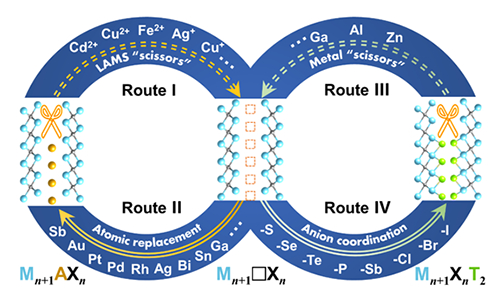Under the support of National Natural Science Foundation of China (Grant No. 91426304, 21671195, 52250005), a team led by Prof. Qing Huang from Ningbo Institute of Materials Technology and Engineering, with their international counterparts, has successfully developed a chemical scissor-assisted strategy for structural editing of layered transition metal carbide/nitride materials. This strategy enables the precise control of composition and topological transformation of these materials, leading to the creation of a new class of two-dimensional carbide/nitride materials with metallic atom intercalations. The research findings titled “Chemical scissor-mediated structural editing of layered transition metal carbides” have been published online on March 17, 2023, in the renowned academic journal, Science. (Accessed via: http://www.science.org/doi/10.1126/science.add5901.
The layered ternary carbides and nitrides are non-van der Waals nano-layered compounds bearing hexagonal crystal structures, with a molecular formula of Mn+1AXn. Nowadays, MAX-phases have received widespread attentions within advanced nuclear energy applications, such as accident-tolerant fuel claddings. Whilst MXenes have shown their great potentials in various fields such as optoelectronic devices, electrochemical energy storage, electromagnetic shielding, surface catalysis, and nuclides separations. The capability of precise control of the interlayer compositions and structures of MAX phases and MXenes has been a significant challenge in achieving their specific functional applications.
With the support of key research projects, such as "Fissile Fuel Breeding and Transmutation of Advanced Nuclear Energy", the research team has been dedicated to the creations and applications of ternary layered carbides/nitrides in the field of nuclear energy. This research has shown that the opening and closing of the non-van der Waals layered materials are completely determined by the types of "chemical scissors", as well as the properties of the guest species. The topological transformations between MAX phases and MXenes can be achieved precisely via four reaction pathways (as shown in the Fig.). The MAX phases undergo multiple steps of interlayer etching and structural assembly according to the topological transformation sequence of "Route I → Route IV → Route III → Route II", where new types of metal-inserted two-dimensional carbides are finally obtained. This research provides an effective structural design methodology for the applications, such as accident-tolerant fuel cladding, electrochemical energy storage, and optoelectronic functional devices of layered materials.

Fig. Schematic illustration of structural editing of MAX phases and MXenes through chemical scissor–mediated intercalation protocol.

Add: 83 Shuangqing Rd., Haidian District, Beijing, China
Postcode: 100085
Tel: 86-10-62327001
Fax: 86-10-62327004
E-mail: bic@donnasnhdiary.org
京ICP备05002826号 文保网安备1101080035号 Copyright 2017 NSFC, All Right Reserved